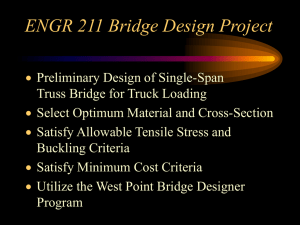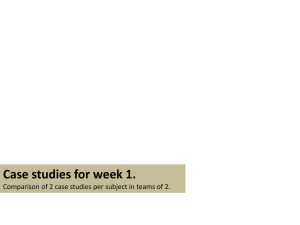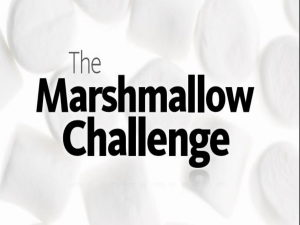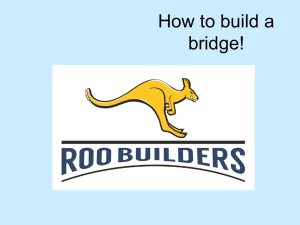Materials, Structures, and Bridge Design
advertisement
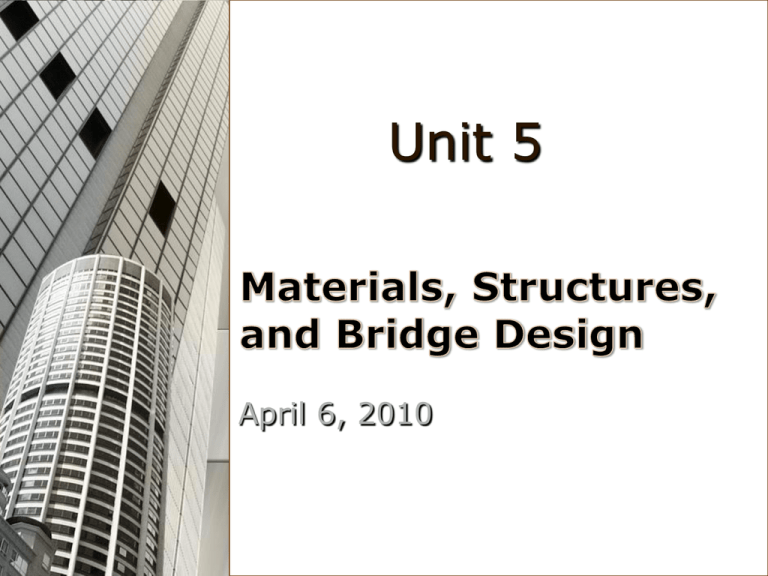
Unit 5 April 6, 2010 Why might Materials and Structures be important to engineers? Structural Thermal Electronic Optical Biotech Mechanical Fluid Electrical Material Unit 5 will answer the following questions: 1. What material properties do we use to characterize materials? 2. How are those properties determined? 3. What are the parameters that affect materials in tension and compression? 4. What are the optimal sizes of tension and compression members to satisfy design requirements? 5. What forces do effective structures overcome? 6. What is a truss and what structural problems do they solve? 7. What sort of calculation goes into bridge design? Let’s look at your Final Engineering Practicum Project: Design and Construction of a Spaghetti Bridge Why a Bridge Project? 1) To take math and science out of the textbook and into a project involving design, planning, and construction. 2) Because the process is instructive and fun, and it exemplifies the difficulties of putting theory into practice. You can build a bridge (or anything, for that matter) without math and science. But – to carry a maximum load, you need to understand material properties, the theory of beams, and the physics of canceling forces (statics). Why Spaghetti? Why not toothpicks or Balsa Wood? 1) Cost 2) Spaghetti is very unforgiving. Design is much more important in a spaghetti bridge than a toothpick/balsa wood one. 3) Available in a nice form for construction – long cylindrical rods. Project Goal: Build a bridge out of spaghetti and epoxy that carries the most load suspended from the middle of the span. Design Criteria/Constraints: Material Constraints: 1) Regular-diameter spaghetti. 2) 5-minute epoxy. Physical Constraints: 1) Minimum length > 50cm 2) 25cm maximum height 3) 250g maximum weight 4) Only horizontal supports on ends 5) Minimum span width 5cm; maximum space between span members, 2mm Grading Criteria: 1) Minimum passing load is 7kg 2) Highest class load determines grading scale (maximum load = 100%) Criteria Schematic: ≥ 5cm ≤ 2mm 5cm x 10cm Loading Platform Bridge Decking ≤ 25 cm ≤ 2.5cm Load 50 cm Total Weight ≤ 250gms Materials and their Properties We’ll begin by answering the question, “Why Epoxy?” Why not white (Elmer’s) glue? 1. It’s water-based – what problem does this pose for spaghetti? Spaghetti is softened by the glue. 2. Glue joints take forever to dry. 3. Once dry, joints are not very strong. Why not model (airplane) glue? Dries quickly, but joints are slightly flexible. We want rigid joints. Why not hot glue? Joints are far too flexible Materials and their Properties “Why Epoxy?” Why Epoxy? 1. It’s not water-based 2. Creates rigid joints 3. Can choose the drying time (5-, 10-, 30-minute Epoxy) What is Epoxy? A polymer formed by the chemical reaction of a “resin” and a “hardener” – two viscous liquids Problems with Epoxy: LOWER HIGHER 1. Irreversible curing 2. Very messy 3. Must mix two equal portions 4. Possible endocrine disrupter and main cause of occupational asthma Materials and their Properties Atoms The story begins with atoms… Various combinations of the 115 or so elements make up all matter on Earth. How? Bonding: 1. Covalent 2. Ionic 3. Metallic 4. Hydrogen 5. Van der Waals forces Materials and their Properties Structure Related to the arrangement of components 1. Any length scale – nanometer, micrometer, meter, etc. 2. Diamond C60 - Fullerene Graphite Carbon nanotubes Materials and their Properties Structure Related to the arrangement of components 1. Any length scale – nanometer, micrometer, meter, etc. 2. Materials and their Properties Properties What is a Material Property? 1. A quantitative trait – tells us something about a material 2. They have units 3. May be constant 4. May be a function of independent variables (like temperature) Materials and their Properties Properties Materials and their Properties Properties What is a Material Property? 1. A quantitative trait – tells us something about a material 2. They have units 3. May be constant 4. May be a function of independent variables (like temperature) Different types of Properties: Mechanical Optical Manufacturing Electrical Acoustical Thermal Radiological Chemical Environmental Magnetic Atomic Mechanical Properties relate deformation to applied load Materials and their Properties Mechanical Properties Young’s Modulus Tensile Strength Compressive Strength Yield Strength Shear Strength Ductility Poisson’s Ratio Specific Weight Specific Modulus Materials and their Properties Mechanical Properties – Stress-Strain Curve Young’s Modulus Typical yield behavior for non-ferrous alloys. 1: True elastic limit 2: Proportionality limit 3: Elastic limit 4: Yield strength Materials and their Properties Mechanical Properties – Stress-Strain Curve Materials and their Properties Mechanical Properties – Stress-Strain Curve Beams and loads--tension: Beam under tension Failure occurs when ultimate tensile strength is exceeded. Maximum load is tensile strength times cross-sectional area. Lmax = T * Acs For regular spaghetti (diameter = 2mm), maximum load is ~ 10 pounds. Load capacity does not depend on length. Beams and loads--compression: d L Beam in compression Failure occurs two ways: 1) When L/d < 10, failure is by crushing 2) When L/d > 10, failure is by buckling We are almost always concerned with failure by buckling. Beams and loads--compressive buckling: Buckling strength F = k * d4/L2 To determine constant of proportionality k: 1) Measure length and diameter of a piece of spaghetti 2) Hold spaghetti vertically on postal scale 3) Press down on spaghetti until it begins to bend 4) Read load F on postal scale 5) Calculate k Some consequences of buckling properties: If a beam of length L and diameter d can support a compressive load of F, d F L then a beam of length L/2 and diameter d can support a compressive load of 4F. d 4F L/2 ALSO… If a beam of length L and diameter d can support a compressive load of F, d F L then a beam of length L and diameter 2d can support a compressive load of 16F. 2d 16F L Bigger beams can be fabricated out of smaller beams, as in a truss. The fabricated beam will have the same buckling strength as a solid beam, provided the buckling/tension strengths of the component beams are not exceeded. Beams and loads--bending: Very little strength. Never design a structure that relies on bending strength to support a load. Beams and loads--bending: Statics – the two conditions for static equilibrium are… F 0 , M 0 1) At each joint or node: F x 0 , F y 0 , F z 0 2) Triangles cancel out moments 3) Joints are assumed to carry no bending loads; therefore all forces are compression or tension and lie in the directions of the beams. y x -F F/2 F/2 Use Bridge Designer to calculate loads: http://www.jhu.edu/~virtlab/bridge/bridge.htm Design and construction ideas: 1) Triangles are a construction engineer’s best friend, i.e. there are no bending moments in triangular elements. Good design Bad design – truss strength depends on bending strengths of members Design and construction ideas (cont.): 2) Taller is better: note loads on these two structures. Design and construction ideas (cont.): 3) Don’t forget about the 3rd dimension. A good design in the x-y plane, may be a terrible one in the z-direction. 4) Recall: tension members do not need to be fabricated as trusses. Their strength depends only on cross- sectional area. 5) Plan the total bridge design. Estimate the weight of each of the components so that you will not exceed the weight limit. 6) Make a full-size pattern of your bridge. Build the bridge on this pattern. This will ensure that all components will assemble properly. Design and construction ideas (cont.): 7) If a number of strands of spaghetti are to be used together as a single member, do not glue their entire lengths. “Spot” glue them at intervals of about 1”. This will provide adequate strength without adding excessive weight. 8) For economy of time, joints should be “overlaid” not “butted”. Butt joints require careful sizing. Overlaid joints do not. Excess material may be cut off after assembly. Butt joints Overlaid joints Which is the better design and why? a) a) b) b) Which is the better design and why? a) a) b) b)


